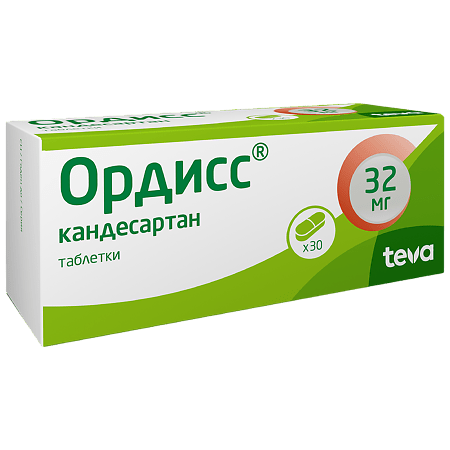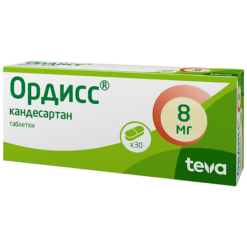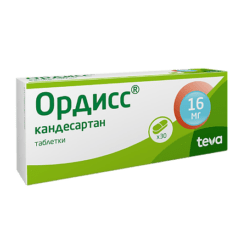Subtotal: €47.34
Ordiss, 32 mg tablets 30 pcs
€31.71 €26.43
Pharmacotherapeutic group: angiotensin II receptor antagonist.
ATX code: C09CA06
Pharmacological properties
Pharmacodynamics
Indications
– Arterial hypertension.
– Chronic heart failure and impaired left ventricular systolic function (decreased LVEF ⤠40%) as adjunctive therapy to angiotensin-converting enzyme inhibitors (ACE) or when ACE inhibitors are intolerant (see section “Pharmacodynamics”).
Active ingredient
Composition
One tablet contains: the active ingredient candesartan cilexetil 8.00 mg/16.00 mg/32.00 mg; excipients: corn pregelatinized starch 3.75 mg/7.50 mg/15.00 mg; poloxamer 188 0.50 mg/1.00 mg/2.00 mg; povidone-K30 4.00 mg/8.00 mg/16.00 mg; iron oxide red dye (E172) 0.075 mg/0.15 mg/0.30 mg; Calcium carmellose 1.65 mg/3.30 mg/6.60 mg; microcrystalline cellulose 17.50 mg/35.00 mg/70.00 mg; lactose monohydrate 43.725 mg/87.45 mg/174.90 mg; magnesium stearate 0.80 mg/1.60 mg/3.20 mg.
How to take, the dosage
The drug Ordiss® should be taken once a day regardless of meals.
Interaction
Dual RAAS blockade with angiotensin II receptor antagonists (ARA II), ACE inhibitors or aliskiren (direct renin inhibitor) may be associated with an increased risk of hypotension, syncope, hyperkalemia and renal dysfunction (including acute renal failure) compared to monotherapy. Regular monitoring of BP, renal function, and blood electrolytes is necessary in patients taking concomitantly candesartan and other drugs that affect the RAAS.
Candesartan is contraindicated concomitantly with aliskiren or aliskiren-containing drugs in patients with diabetes mellitus and/or with moderate to severe renal function impairment (GFR less than 60 ml/min/1.73 m2 body surface area) and is not recommended in other patients.
The concomitant use of angiotensin II receptor antagonists with ACE inhibitors is contraindicated in patients with diabetic nephropathy and is not recommended in other patients.
The simultaneous use of ACE inhibitors and dipeptidyl peptidase type 4 inhibitors (e.g., vildagliptin) may increase the risk of Quincke’s edema. No clinically significant drug interactions have been observed with candesartan concomitantly with hydrochlorothiazide, warfarin, digoxin, oral contraceptives (ethinylestradiol/levonorgestrel), glibenclamide, nifedipine and enalapril. Candesartan is slightly metabolized in the liver with participation of CYP2C9 isoenzyme. Interaction studies have shown no effect of candesartan on CYP2C9 and CYP3A4 isoenzymes, the effect on other cytochrome P450 isoenzymes has not been studied. Concomitant use of candesartan with other hypotensive agents increases the antihypertensive effect.
The experience with other drugs acting on RAAS shows that concomitant therapy with potassium-saving diuretics, potassium preparations, table salt substitutes containing potassium, and other agents that increase serum potassium (e.g., heparin) may lead to hyperkalemia.
When concomitant use of lithium preparations and ACE inhibitors a reversible increase in serum lithium concentration and development of toxic reactions occurs. These reactions may also occur with angiotensin II receptor antagonists, and therefore it is recommended that serum lithium levels be monitored.
. Concomitant use with non-steroidal anti-inflammatory drugs (NSAIDs), including selective cyclooxygenase-2 inhibitors (COX-2), acetylsalicylic acid (over 3 g/day) and non-selective NSAIDs, may reduce the antihypertensive effect of candesartan, and may also lead to increased risk of renal dysfunction, including acute renal failure and increased serum potassium. The combination of these drugs should be used with caution, especially in elderly patients.
Special Instructions
The concomitant use of ACE inhibitors, ARA II or aliskiren increases the risk of hypotension, hyperkalemia and renal dysfunction (including acute renal failure). Dual RAAS blockade in concomitant use of ACE inhibitors, ARA II with drugs containing aliskiren is contraindicated in patients with diabetes and/or with moderate or severe renal insufficiency (glomerular filtration rate (GFR) less than 60 ml/min/1.73 m2 body surface area) and is not recommended in other patients, (see section “Interaction with other medicinal products”).
If dual RAAS blockade is considered absolutely necessary, the treatment should take place only under medical supervision and should be accompanied by careful and regular monitoring of renal function, electrolytes and blood pressure. Concomitant use of angiotensin II receptor antagonists with ACE inhibitors is contraindicated in patients with diabetic nephropathy and is not recommended in other patients.
Kidney function impairment. In some cases, renal dysfunction may develop with use of Ordiss®, as with other drugs that inhibit the RAAS.
When using Ordiss® in patients with severe arterial hypertension and renal insufficiency (GFR less than 30 ml/min/1.73 m2 body surface area), it is recommended to monitor regularly potassium and serum creatinine concentration. Clinical experience concerning this medicine use in patients with end-stage renal failure (FFR less than 15 ml/min/1.73 m2 of body surface area) is limited. When using Ordiss® in such patients, the dose of Ordiss® should be adjusted under BP control.
In patients with CHF, renal function should be monitored periodically, especially in patients over 75 years of age and in patients with impaired renal function. When increasing the dose, it is also recommended that serum potassium and creatinine concentrations be monitored.
The use of Ordiss® in patients with chronic heart failure with creatinine greater than 265 µmol/L (greater than 3 mg/ml) is not known.
Hemodialysis.
Synopsis
Tablets 8 mg. Capsule-shaped pink tablets with a rib on both sides. One side of the tablet is engraved “C|8” and the other side is engraved “8|C”.
Tablets 16 mg. Capsule-shaped pink tablets with a ridge and engraving “C|C” on one side and engraving “16” on the other side.
Tablets 32 mg. Pink capsule-shaped tablets with a ridge and engraving “C | C” on one side and engraving “32” on the other side.
Contraindications
Hypersensitivity to candesartan and other drug components; lactose intolerance; lactase deficiency; glucose-galactose malabsorption syndrome; severe hepatic impairment and/or cholestasis; pregnancy; breastfeeding period; children under 18 years of age; concomitant use with aliskiren or drugs containing aliskiren in patients with diabetes mellitus and/or moderate or severe renal dysfunction (glomerular filtration rate (GFR) less than 60 ml/min/1.73 m2 body surface area), concomitant use with ACE inhibitors in patients with diabetic nephropathy.
With caution
. Hemodynamically significant aortic and mitral valve stenosis, cerebrovascular disease, coronary heart disease (CHD), hypertrophic obstructive cardiomyopathy (HOCMP), post kidney transplant condition, bilateral renal artery stenosis or stenosis of the artery of a single kidney, primary hyperaldosteronism, severe renal failure (creatinine clearance (CK) less than 30 ml/min), hemodialysis, hyperkalemia; in patients with decreased volume of circulating blood (VBI), general anesthesia and surgical interventions (risk of arterial hypotension due to RAAS blockade).
Side effects
Arterial hypertension
Side effects in clinical trials were moderate and transient. The overall incidence of side effects on candesartan was independent of the drug dose, sex and age of the patient. The incidence of discontinuation of therapy due to side effects was similar for candesartan cilexetil (3.1%) and placebo (3.2%). A pooled analysis of data from clinical trials in patients with arterial hypertension identified adverse reactions with candesartan cilexetil that occurred at least 1% more frequently than in the placebo group. The most commonly reported adverse reactions were dizziness/vertigo, headache, and respiratory infections.
The following are the adverse reactions reported in clinical trials and post-registration use: Very frequently, 1/10 appointments (>10%), frequently, from 1/100 appointments ( >1% and < 10%), infrequently, from 1/1000 appointments ( >0.1% and < 1%), rarely, from 1/10000 appointments ( > 0.01% and < 0.1%) , very rarely, from < 1/10000 appointments (< 0.01%), frequency unknown (cannot be determined from available data).
Infectious and parasitic infections: often – respiratory infections.
Disorders of the blood and lymphatic system: very rarely – leukopenia, neutropenia, agranulocytosis.
Disorders of metabolism and nutrition: very rarely – hyperkalemia, hyponatremia.
Nervous system disorders: frequently – dizziness/vertigo, headache. Disorders of the respiratory system, thorax and mediastinum: very rarely – cough.
Gastrointestinal tract disorders: very rare – nausea; frequency unknown – diarrhea.
Hepatic and biliary tract disorders: very rare – increased activity of “liver” enzymes, liver dysfunction or hepatitis.
Dermatological and subcutaneous tissue disorders: very rarely – angioedema, skin rash, itching, urticaria.
Skeletal-muscular system and connective tissue disorders: very rarely – back pain, arthralgia, myalgia.
Repnal and urinary tract disorders: frequently – renal dysfunction, including renal failure in predisposed patients.
Laboratory findings: In general, no clinically significant changes in standard laboratory parameters have been observed with candesartan cilexetil. As with other drugs affecting the RAAS, a slight decrease in hemoglobin was observed. Regular monitoring of laboratory parameters is usually not required when using candesartan. However, in patients with impaired renal function, periodic monitoring of serum potassium and creatinine concentration is recommended.
Chronic Heart Failure
The side effects observed with candesartan in adult patients with chronic heart failure were consistent with the pharmacological properties of the drug and depended on the patient’s condition. The clinical studies compared candesartan cilexetil in doses up to 32 mg (n=3803) with placebo (n=3796); 21% of patients in the candesartan cilexetil group and 16.1% of patients in the placebo group discontinued treatment because of adverse reactions. The most common adverse reactions were hyperkalemia, arterial hypotension, and renal dysfunction. These reactions occurred most frequently in patients older than 70 years of age, with diabetes mellitus, or in patients treated with other drugs that affect the RAAS, particularly ACE inhibitors and/or spironolactone.
The following are the adverse reactions reported in clinical trials and post-registration use: very frequently, 1/10 prescriptions (>10%), frequently, from 1/100 prescriptions ( >1% and < 10%), infrequently, from 1/1000 prescriptions ( >0.1% and < 1%), rarely, from 1/10000 prescriptions ( > 0.01% and < 0.1%) , very rarely, from < 1/10000 appointments (< 0.01%), frequency unknown (cannot be determined from available data).
Disorders of the blood and lymphatic system: very rarely – leukopenia, neutropenia, agranulocytosis.
Disorders of metabolism and nutrition: often – hyperkalemia, very rarely – hyponatremia.
Skin and subcutaneous tissue disorders: very rarely – angioedema, skin rash, itching, urticaria.
Nervous system disorders: very rarely – dizziness, headache.
Disorders of the respiratory system, the thorax and mediastinum: very rarely – cough.
Gastrointestinal tract disorders: very rare – nausea; frequency unknown – diarrhea.
vascular disorders: frequently – arterial hypotension.
Hepatic and biliary tract disorders: very rarely – increased activity of “liver” enzymes, liver dysfunction or hepatitis.
Muscular system and connective tissue disorders: very rarely – back pain, arthralgia, myalgia.
Repnal and urinary tract disorders: frequently – renal dysfunction, including renal failure in predisposed patients.
Laboratory findings: Frequently, hyperkalemia and impaired renal function are observed in treated heart failure. Periodic monitoring of potassium and serum creatinine concentration is recommended.
Overdose
Pregnancy use
Similarities
| Weight | 0.010 kg |
|---|---|
| Shelf life | 2 years. Do not use after the expiration date. |
| Conditions of storage | At a temperature not exceeding 25 ° C, in the original package. Keep out of reach of children! |
| Manufacturer | Pliva Hrvatska d.o.o., Croatia |
| Medication form | pills |
| Brand | Pliva Hrvatska d.o.o. |
Other forms…
Related products
Buy Ordiss, 32 mg tablets 30 pcs with delivery to USA, UK, Europe and over 120 other countries.
















